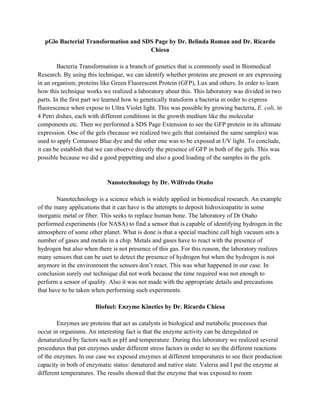
7 10. carlos p glo & sds, nano, biofueled
- 1. pGlo Bacterial Transformation and SDS Page by Dr. Belinda Roman and Dr. Ricardo Chiesa Bacteria Transformation is a branch of genetics that is commonly used in Biomedical Research. By using this technique, we can identify whether proteins are present or are expressing in an organism; proteins like Green Fluorescent Protein (GFP), Lux and others. In order to learn how this technique works we realized a laboratory about this. This laboratory was divided in two parts. In the first part we learned how to genetically transform a bacteria in order to express fluorescence when expose to Ultra Violet light. This was possible by growing bacteria, E. coli, in 4 Petri dishes, each with different conditions in the growth medium like the molecular components etc. Then we performed a SDS Page Extension to see the GFP protein in its ultimate expression. One of the gels (because we realized two gels that contained the same samples) was used to apply Comassee Blue dye and the other one was to be exposed at UV light. To conclude, it can be establish that we can observe directly the presence of GFP in both of the gels. This was possible because we did a good pippetting and also a good loading of the samples in the gels. Nanotechnology by Dr. Wilfredo Otaño Nanotechnology is a science which is widely applied in biomedical research. An example of the many applications that it can have is the attempts to deposit hidroxioapatite in some inorganic metal or fiber. This seeks to replace human bone. The laboratory of Dr Otaño performed experiments (for NASA) to find a sensor that is capable of identifying hydrogen in the atmosphere of some other planet. What is done is that a special machine call high vacuum sets a number of gases and metals in a chip. Metals and gases have to react with the presence of hydrogen but also when there is not presence of this gas. For this reason, the laboratory realizes many sensors that can be uset to detect the presence of hydrogen but when the hydrogen is not anymore in the environment the sensors don’t react. This was what happened in our case. In conclusion surely our technique did not work because the time required was not enough to perform a sensor of quality. Also it was not made with the appropriate details and precautions that have to be taken when performing such experiments. Biofuel: Enzyme Kinetics by Dr. Ricardo Chiesa Enzymes are proteins that act as catalysts in biological and metabolic processes that occur in organisms. An interesting fact is that the enzyme activity can be deregulated or denaturalized by factors such as pH and temperature. During this laboratory we realized several procedures that put enzymes under different stress factors in order to see the different reactions of the enzymes. In our case we exposed enzymes at different temperatures to see their production capacity in both of enzymatic status: denatured and native state. Valeria and I put the enzyme at different temperatures. The results showed that the enzyme that was exposed to room
- 2. temperature maintained the enzymatic integrity and thus had a greater capacity for work. On the other hand, the enzymes that were exposed to hot or cold temperatures had a low enzymatic capacity respectively. This shows that the temperature factors do affect the integrity of the enzyme or denaturation process. Carlos Santos Perez 804-10-8280 University of Puerto Rico Cayey P.R.